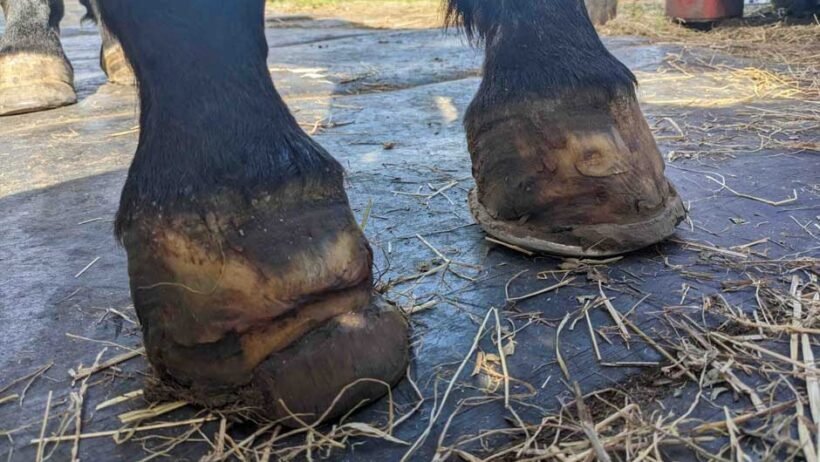Understanding Founder Hoof
Founder, also known as laminitis, is one of the most devastating hoof conditions a horse can experience. It affects not only the animal’s ability to walk but also its overall quality of life. For centuries, horse owners, veterinarians, and researchers have sought better ways to prevent and treat this painful condition. Founder hoof has been the subject of countless studies, therapies, and farrier innovations, yet it remains one of the most stubborn and heartbreaking challenges in equine health. The possibility of a breakthrough remedy has the potential to transform equine medicine and reshape the way we care for horses worldwide.
The Impact of Founder on Horses
Founder occurs when the sensitive laminae within the hoof become inflamed and damaged, causing the coffin bone to rotate or sink. This process creates excruciating pain and can lead to permanent lameness or, in severe cases, euthanasia. Because the hoof supports the horse’s entire body weight, even small disruptions in its structure can lead to catastrophic consequences. The severity of founder varies, but once it takes hold, reversing the damage is notoriously difficult. For this reason, prevention has long been the main focus, but the quest for a reliable treatment continues.
Current Treatment Approaches
Traditional approaches to managing founder hoof include corrective shoeing, anti-inflammatory medications, strict dietary controls, and, in some cases, surgical intervention. These methods often provide partial relief and can stabilize a horse’s condition, but they rarely restore the animal to full health. Many horses remain vulnerable to recurrent episodes, forcing owners into a cycle of constant vigilance and expense. The elusive dream of a true remedy, one that addresses the root causes of founder, is what makes current research so exciting.
Regenerative Medicine and New Therapies
Modern veterinary science has begun exploring novel therapies that could unlock new possibilities. One area of interest is regenerative medicine, which focuses on helping the body repair itself at a cellular level. Stem cell treatments, platelet-rich plasma injections, and advanced biologics are being studied for their ability to heal damaged laminae and restore hoof integrity. Early results show promise, though widespread clinical success has not yet been achieved. If a regenerative therapy could rebuild the internal structures of the hoof, it would represent a genuine breakthrough for horses suffering from founder hoof.
Genetic Research and Prevention
Another frontier is genetic research. Horses, like people, carry genetic markers that may predispose them to certain conditions. Understanding whether some animals are more prone to laminitis could pave the way for targeted breeding programs or preventive strategies tailored to an individual horse’s genetic profile. If science can identify and reduce hereditary risks, the overall incidence of founder hoof may decline significantly over the long term.
The Role of Nutrition
Nutrition also plays a central role in both prevention and treatment. High-sugar diets, obesity, and metabolic disorders are strongly linked to laminitis. Advances in equine nutrition have already helped many owners manage risk factors, but ongoing studies suggest that specific supplements, herbs, or feed formulas may further support hoof health at a biochemical level. A nutritional remedy, especially if combined with other therapies, could offer a practical and accessible solution for horse owners worldwide.
Advances in Farrier Science
Farrier science continues to evolve as well. Corrective trimming and specialized shoeing can relieve pressure on the damaged areas of the hoof and improve circulation. New materials such as composite shoes and 3D-printed hoof supports are being tested to provide better biomechanical support. While these tools are not cures, they can greatly improve comfort and mobility. Pairing innovative farrier techniques with medical therapies may prove to be the key to comprehensive care.
Why the Industry Needs a Breakthrough
The global horse industry, which encompasses racing, show jumping, dressage, and recreational riding, has a vested interest in solving the problem of founder hoof. Beyond the economic implications, the welfare of millions of horses is at stake. Owners and veterinarians alike share the frustration of losing a beloved animal to a condition that, despite all our modern knowledge, remains difficult to defeat. A true remedy would not only save horses but also bring peace of mind to those who care for them.
A Multifaceted Solution
Skeptics point out that no single cure is likely to emerge. Instead, they argue, the best hope lies in combining multiple approaches into a comprehensive treatment plan. For example, regenerative therapies could be used to repair damage, while advanced shoeing provides mechanical support, and carefully designed diets address underlying metabolic issues. In this sense, the “remedy” for founder hoof may not be one magic bullet but rather a suite of tools and strategies that, when used together, finally give horses a fighting chance.
Case Studies and Success Stories
Recent case studies highlight the potential of integrative treatment. Some horses treated with stem cells and corrective shoeing have regained mobility once thought impossible. Others have responded remarkably well to new diet protocols focused on low-starch forage and balanced mineral supplementation. These stories inspire optimism, though controlled clinical trials are needed to validate anecdotal success.
The Emotional Toll on Horse Owners
The emotional toll of founder hoof cannot be understated. Horses are more than just animals to many people. They are companions, partners in sport, and symbols of freedom and beauty. Watching a horse struggle with pain, unable to walk or run, is heartbreaking. Owners often face difficult decisions when treatment options fail, and the possibility of euthanasia weighs heavily. A true remedy would not only change outcomes but also bring emotional relief to countless horse lovers.
The Challenge of Funding Research
On the research front, funding remains a significant challenge. Equine medicine does not receive the same level of investment as human healthcare, which slows the pace of discovery. Many breakthroughs rely on small studies, private funding, or passionate veterinarians conducting field trials. Greater collaboration between universities, pharmaceutical companies, and equine organizations could accelerate progress. If the industry unites behind the mission to conquer founder hoof, a viable remedy may be within reach sooner than expected.
The Role of Technology in the Future
The future may also involve technology. Advanced imaging techniques such as MRI and CT scans are giving veterinarians clearer insights into the structures inside the hoof. These tools allow for earlier detection of laminitis and more precise monitoring of treatment outcomes. Artificial intelligence may soon assist in analyzing vast datasets from clinical trials, identifying patterns that human researchers might miss. Technology, paired with biology, could be the final ingredient needed to unlock a breakthrough.
A Hopeful Future for Horses
In conclusion, the possibility of a remedy for founder hoof represents more than just a medical advance. It symbolizes hope for horses and their caretakers around the world. While challenges remain, the combination of regenerative medicine, genetics, nutrition, farriery, and technology paints a hopeful picture. A cure may not arrive in the form of a single pill or injection, but a comprehensive approach that restores health and mobility is within sight. The search continues, fueled by love for the horse and a determination to end the suffering caused by founder. If the breakthroughs now on the horizon can be realized, the impact will be nothing short of transformative for the equine world.







